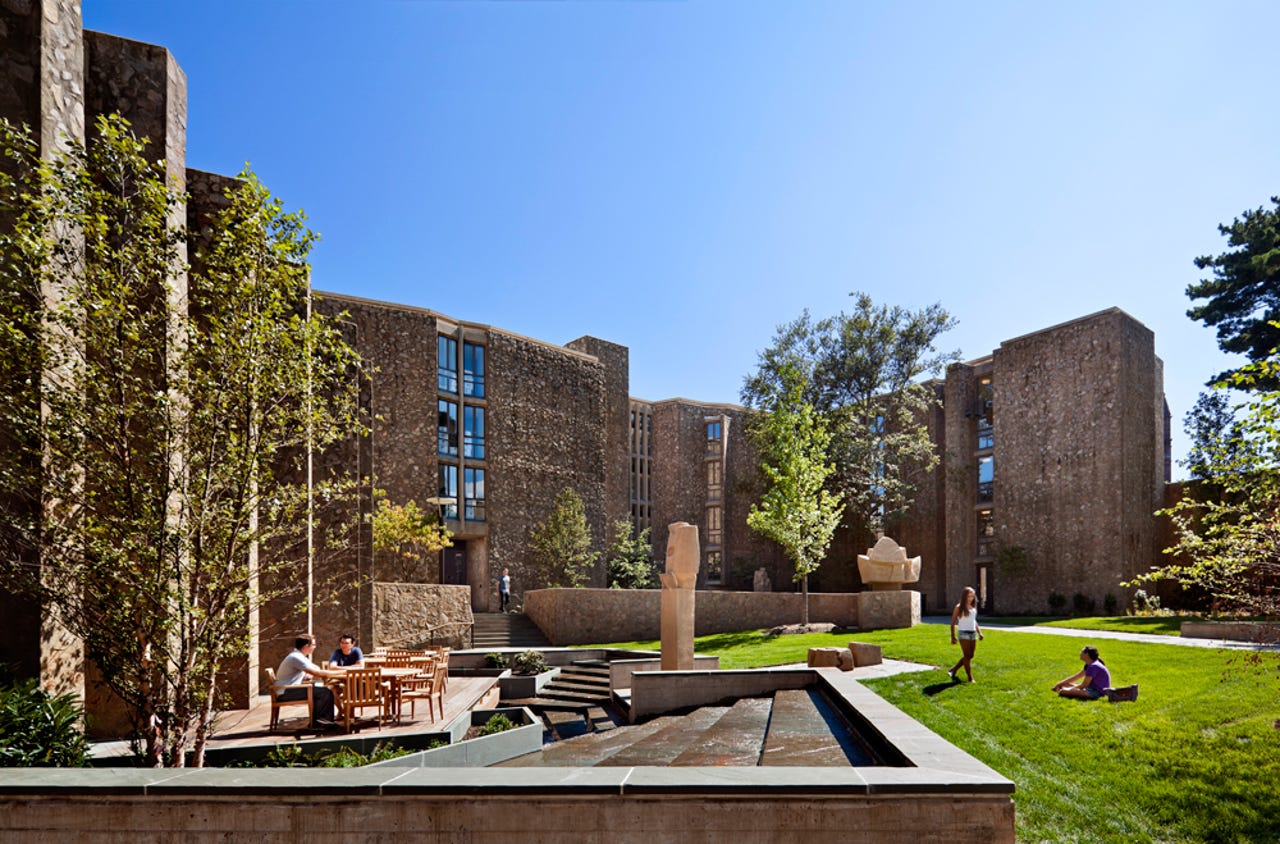Why forward-thinking Yale is opting for backward-looking architecture

Yale University's design for two new dormitory complexes sums up the retrograde nature of too much American university architecture today.
The new Yale plan? Stay on brand. Make the college more marketable. Revive its glorious past of fake-old buildings with yet more fake-old buildings.
This strategy may be good for the big business that is higher education today, but it signals surrender in architectural terms.
Quick: Can you name one university creating original, exciting ideas in city-making and architecture? In Europe or China, certainly. In the United States, the best recent examples are in California and the Southwest; otherwise, you have to look back to the mid-20th century: Cranbrook. Brandeis University. Illinois Institute of Technology. Even Yale.
Back in 1962, when the latter expanded its undergraduate residences with two dorms designed by Eero Saarinen, the brash architect who died the year before at 51, it entered what the architect himself described as "unchartered waters." His Morse and Stiles residential complex (pictured below) was considered revolutionary at the time. Yale drew acclaim from London, Rome and Tokyo for its new architectural statement. Saarinen's design was seen as a built metaphor for the university's leadership in the arts and emerging social sciences.

Later, there was backlash. By the end of the decade, the experiment's gloss gave way to daily hassles like unreliable elevators and fogged windows. Its sullen modernity became mythic, but never voguish.
That was the last time Yale built undergrad residences. But in 2003, the need for expansion hit the news, and it seemed an opportunity to test unchartered architectural waters again, perhaps with a new international icon. Exciting!
So what's the next big thing for architecture on Yale's campus? It seems to be an uncritical look backward to 70 years ago, back when women weren't allowed into the school, and back when Yale poached a pattern book from England's Oxford and Cambridge universities. Yes, this Connecticut-based school known for producing forward thinkers is readying a $600 million faux-historical expansion of its Collegiate Gothic dormitory system, called "residential colleges."
Each college in the system is a uniquely branded, self-supporting mini-campus with integral housing, dining, studying and loafing areas, all organized around quadrangles with the exception of Saarinen's two existing dorms. (Disclosure: I lived in one while at Yale in the mid-1980s.)
College house systems must include certain amenities and traits to succeed. Their size should allow for "cohesiveness and intimacy," as Yale officials put it. But they don't have to be stylistically identical, as shown by such campuses such as Franklin & Marshall (image below), which recently converted to a residential college house system.
Yet identical is what Yale will get in its new undergraduate housing, as currently proposed. In the new-old design, the New Haven campus will expand on the triangular plot just north of its main undergrad campus with what amounts to a spot-on replica of the other campus quads.
Instant old
The naming of Robert A.M. Stern, one of America's most celebrated architects and thinkers as well as dean of Yale's architecture school, made sense. Stern is a prolific writer and a skilled designer in all idioms: the neo-Georgian business school at Harvard University, the new urbanism of Celebration, Fla., and his Shingle-style beach homes for the rich and fabulous.
To be fair, there are subtle new design ideas in the Yale residential complex. Stern is highly regarded for masterfully manipulating historical styles. A recent facade mockup reveals how the buildings will create an instant antique feel, using techniques for rusticated brick and mottled stonework.
What's behind this latest example of a national wave of new higher-ed historicism? Is it ivory tower purity? Competition for big-ticket donors? Or maybe what some call the "Harry Potterization" of U.S. schools? At least one prospective donor I talked to said Yale leaders were influenced by Princeton University's expansion with Whitman College, designed by London's über-traditionalist architect Demetri Porphyrios. The Yalies liked what they saw, but perhaps they needed to raise the stakes so as not to be outflanked. An even bigger, even more tradition-bound expansion could be considered an effective counter.
Whatever it is, none of it is progressive or even conducive to liberal arts studies. In fact, by creating a living, breathing half-billion-dollar museum piece, Yale's momentous expansion might actually stick a thumb in the eye of contemporary higher education.
How does Dean Stern defend his work? In general he likes to call his approach "modern traditionalist," which holds no meaning against the gilded simulacrum we see in Yale's highly produced renderings and videos of the planned new buildings. The two new enclaves are clearly meant to mirror each other, and they are styled to match the work of James Gamble Rogers, who designed most of the other residential complexes in the 1920s. "The two newest colleges, carrying forward the spirit of Rogers's Gothic, are designed as fraternal twins, similar in size and palette but each enjoying its own identity and organization," says Stern's Web site.
His sterling architectural credentials aside, Stern's spirit-carrying seems one part triangulation and another part cold, calculated branding. It also suggests that Yale has no room for experiments nor errors here: Instead, it is retrenching, seeking to reclaim its hundred-year-old architectural brilliance. What worked then must be right for the now. Let's be reverent. Tradition!
Tradition and academic progress
These could be the meta-level messages coming from this top research institution, a place that produces world-class leaders and critical thinkers. It all seems a bit defeatist to the architecture and arts worlds: Are we simply no better, and perhaps even the same as we were a century ago, when men donned straw boaters and suit jackets for classes in May?
For the craft and art of architecture, I worry about a $600 million missed opportunity, no matter how successfully resolved Stern's composition turns out. If there are advancements, they are well cloaked. Where we see fake-historical building designs, we assume a lack of invention and little progress on the architectural front. It also gives the impression of moneyed, socially conservative interests on the wax. We take part in a misty-eyed look back to other eras where things seemed so much better, and so much simpler. (In this regard, Yale's promotional video is quite telling.)
This is all happening, by the way, during a time of high economic inequality and social uncertainty. This, too, also reflects Yale's past: Its other old-looking residential colleges broke ground in the 1920s amid an unprecedented, massive building campaign. Money from Standard Oil, through the benefactor Edward Harkness, funded much of that expansion, turning the campus into the picture-postcard Yale we know today.
Most of the original residential colleges were designed by Rogers. They are delightfully extravagant, replete with gargoyles, quoins and small, dark arched entries.
Not surprisingly, the elite sense of the donor's gift and building designs became, for a while, a part of the individual dorm branding. The ones called Branford College and Davenport College, for example, became known for their rich legacy students. Others, such as Trumbull College, were considered places for students on academic scholarships. As some current Yale students recently reminded me, eight of the 12 built were named for slaveowners, casting some metaphorical shadows on the Georgian Revival facades and outbuildings that recall plantation architecture. These facts have led to periodic calls for renaming by some students and alums.
It's useful to note that Yale had no overt religious or spiritual intentions in building those first residential colleges or even Harkness Tower, the neo-Gothic statuary that dominates campus.
Yet places where contemporary revivals of fake history can be seen are often places of religious idealism and conformity. Ave Maria University, a private Catholic college founded in 2003 near Naples, Fla., is a prime example. The planned town it dominates with a horseshoe-shaped drive and an unusually beautiful though over-scaled oratory is made of the latest, highly insulating materials – foam plastic, manufactured stone and synthetic stucco – yet its detailing suggests a 19th-century Mediterranean village.
Dropped within the Ave Maria framework, however, are a few modernist elements, such as the Frank Lloyd Wright-inspired Canizaro Library, also by CannonDesign. These flourishes were important signals for recruiting serious faculty and students — some of whom might wonder about the school's interest in modern academic inquiry, a challenging mindset that at times causes friction with Catholic beliefs.
In spite of the nice library, Ave Maria stands as the true realm of historic revivalism, in my view, where educational philosophy and architectural aesthetics are in a special kind of harmony. At Yale, on the other hand, with its campus full of modern architectural wonders, the decision to build classical, traditional, historic undergrad residences seems rather out of synch. It suggests to outsiders that Yale chooses to live in the past, even as its students and faculty study in the present, planning for a better future.
Will those undergrads uncritically inhabit the past in their brand-new suites and dining halls? A few years from now, will students wonder when their dorm was built? Maybe. But wide-eyed undergrads will likely report good vibes back to mom and dad. Alumni and legacy families will love it.
It's a crowd-pleasing move. The new residential colleges will burnish the "old Yale" brand, helping push back against the other hard-charging Ivy Leaguers and other competitive colleges.
Yes, the traditional and historical architecture will work, in large measure because it will trick us into thinking we don't inhabit the modern world. And architecture – as an art form, business or science – will have advanced not a step.
Image credits: (With headline) A still from a Yale University video fly-through of its new residential colleges designed by Robert A.M. Stern; the renovated Morse & Stiles Colleges image courtesy Kieran Timberlake; Franklin & Marshall photo by Halkin Mason and courtesy MGA Partners; Ave Maria University image courtesy Hypower.
Sign up for our newsletter featuring in-depth business innovation stories by correspondents around the globe, top domestic reporters and thought-provoking opinion columnists.
This post was originally published on Smartplanet.com